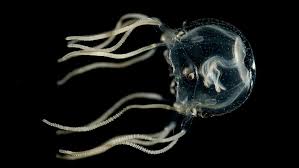Jellyfish : Recent Studies

Recent studies indicate that jellyfish blooms are increasing along Indian coasts.
- It is an ancient and resilient gelatinous zooplankton of the phylum Cnidaria.
- These are highly adaptable marine organisms with simple anatomy, stinging tentacles and efficient jet propulsion.
- These are simple invertebrates, members of the phylum Cnidaria, which includes creatures such as sea anemones, sea whips, and corals.
- The body parts of a jellyfish radiate from a central axis. This “radial symmetry” allows jellyfish to detect and respond to food or danger from any direction.
- They are pretty simple, lack brains, blood, or even hearts.
- They are composed of three layers: an outer layer, called the epidermis; a middle layer made of a thick, elastic, jelly-like substance called mesoglea; and an inner layer, called the gastrodermis.
- Jellyfish have the ability to sting with their tentacles.
- They play essential roles in marine food webs as both predators and prey.
- Its populations can explode into dense “blooms” under favourable conditions — events increasingly driven by human-induced and environmental stressors.]
- These blooms disrupt marine ecosystems by reducing biodiversity, outcompeting native species and collapsing fish and invertebrate populations.
- They also pose economic and operational challenges by clogging fishing nets, damaging aquaculture gear, blocking power plant intakes and affecting tourism.




